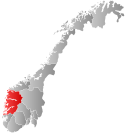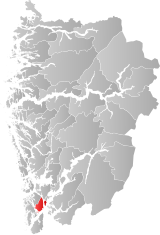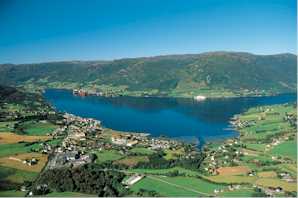
Ølen is a former municipality in the Vestlandet region of Norway. The municipality existed from 1916 until 2006, and originally it was a part of Hordaland county, but in 2002 it was transferred to Rogaland county prior to its dissolution in 2006. The 181-square-kilometre (70 sq mi) municipality was located on the south side of the Bjoafjorden and east of the Ålfjorden. The administrative center of Ølen was the village of Ølensjøen. The municipality of Ølen makes up the northern part of the present-day Vindafjord Municipality in Rogaland county.

Suldal is a municipality in the northeast corner of Rogaland county, Norway. It is located in the traditional district of Ryfylke. Since 1965, the administrative centre of Suldal is the village of Sand i Ryfylke. Other villages in Suldal include Haugsland, Jelsa, Marvik, Nesflaten, and Suldalsosen.
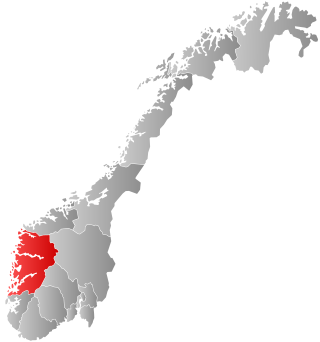
Etne is a municipality in Vestland county, Norway. It is located in the traditional district of Sunnhordland, although it is also sometimes considered to be part of the district of Haugaland. The administrative centre of the municipality is the village of Etnesjøen. Other villages in the municipality include Skånevik and Fjæra. The two largest villages in the municipality are Etnesjøen with 1,159 residents and Skånevik with 594 residents.

Sveio is a municipality in Vestland county, Norway. Sveio is a border district that is sometimes considered to be located in the traditional district of Haugalandet since it is located on the Haugalandet peninsula, but it is also considered to be in the traditional district of Sunnhordland since it is located in southern Hordaland county. The administrative centre of the municipality is the village of Sveio. Other villages in the municipality include Auklandshamn, Førde, Våga, and Valevåg.

Bømlo is a municipality in the southwestern part of Vestland county, Norway. It is located in the traditional district of Sunnhordland. The administrative centre of the municipality is the village of Svortland. Other villages in Bømlo include Mosterhamn, Rubbestadneset, Lykling, and Langevåg. Most of the municipal residents live on the island of Bømlo, which makes up the majority of the land in the municipality.
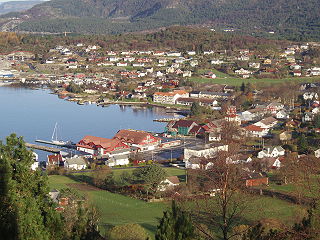
Fitjar is a municipality in Vestland county, Norway. The municipality is located in the traditional district of Sunnhordland. Fitjar municipality includes the northern part of the island of Stord and the hundreds of surrounding islands, mostly to the northwest of the main island. The administrative centre of the municipality is the village of Fitjar.
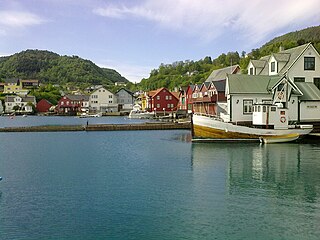
Tysnes is a municipality in Vestland county, Norway. It is located in the traditional district of Sunnhordland. The administrative centre is the village of Uggdal. Other population centres in Tysnes include the villages of Våge and Onarheim. The island municipality is located in a group of islands near the mouth of the Hardangerfjorden. The majority of the municipal population lives on the island of Tysnesøya, the largest island in the municipality.
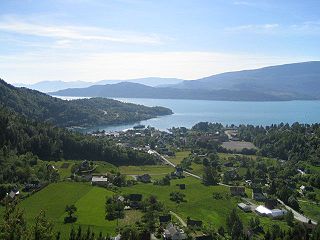
Jondal is a former municipality in the old Hordaland county, Norway. The 247-square-kilometre (95 sq mi) municipality existed from 1863 until its dissolution in 2020 when it became part of Ullensvang Municipality in Vestland county. It was located on the Folgefonna peninsula in the Hardanger district, on the eastern shore of the Hardangerfjorden. The administrative centre of the municipality was the village of Jondal. Other villages in Jondal include Herand, Kysnesstranda, and Torsnes.

Lindås is a former municipality in the Nordhordland district in the old Hordaland county, Norway. It existed from 1838 until its dissolution on 1 January 2020 when it was merged into the new Alver Municipality. The administrative centre of the municipality was the village of Knarvik, located in the southwestern part of the municipality. Other notable villages in the municipality included Alversund, Isdalstø, Lindås, Ostereidet, and Seim. The Mongstad industrial area in extreme northern Lindås has one of the largest oil refineries and largest seaports in Norway. The oil refinery at Mongstad is by far the largest employer in the municipality.
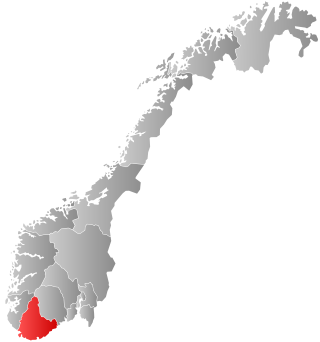
Hægebostad is a municipality in Agder county, Norway. It is located in the traditional district of Lister. The administrative centre of the municipality is the village of Tingvatn. Other villages in Hægebostad include Eiken, Haddeland, and Snartemo. The municipality encompasses the northern end of the Lyngdalen valley which follows the river Lygna.

Tustna is a former municipality in Møre og Romsdal county, Norway. The administrative centre was the village of Gullstein. The municipality is located in the present-day Aure Municipality. The municipality included the main islands of Tustna, Stabblandet, and Solskjelsøya, as well as many smaller, surrounding islets between the Edøyfjorden and the Vinjefjorden. In 2006, when the municipality was merged into Aure, it was 141 square kilometres (54 sq mi).

Fræna is a former municipality in Møre og Romsdal county, Norway. It was part of the region of Romsdal. The municipality was located on the Romsdal peninsula surrounding the Frænfjorden, the eastern shore of the Julsundet strait, and includes most of the Hustadvika area. It also included the now-abandoned Bjørnsund islands.

Eide is a former municipality in Møre og Romsdal county, Norway. It was part of the region of Nordmøre. It was located on the Romsdal peninsula, along the Kornstadfjorden and the Kvernesfjorden. The administrative centre of the municipality was the village of Eide. Other villages included Lyngstad, Vevang, and Visnes.

Flatanger is a municipality in Trøndelag county, Norway. It is part of the Namdalen region. The administrative centre of the municipality is Lauvsnes. Other villages include Jøssund, Hasvåg, and Vik.

Vevelstad is a municipality in Nordland county, Norway. It is part of the Helgeland traditional region. The administrative centre of the municipality is the village of Forvik. The municipality is relatively small and isolated, with no road connections to the rest of Norway. It is only accessible by ferry, despite much of the municipality being located on the mainland.

Nesna is a municipality in Nordland county, Norway. It is part of the Helgeland traditional region. The administrative centre of the municipality is the village of Nesna. Other villages in Nesna include Handnesneset, Husby, Saura, and Vikholmen.

Skånland is a former municipality in Troms county, Norway. The 495-square-kilometre (191 sq mi) municipality existed from 1926 until its dissolution in 2020 when it was merged into Tjeldsund Municipality. It was part of the Central Hålogaland region, just southeast of the city of Harstad. The administrative centre of the municipality was the village of Evenskjer. Other villages included Grovfjord, Renså, Sandstrand, and Tovik.

Gratangen (Norwegian) or Rivtták (Northern Sami) is a municipality in Troms county, Norway. It is part of the traditional region of Central Hålogaland. The administrative centre of the municipality is the village of Årstein.

Tromøy is a former municipality in the old Aust-Agder county in Norway. The 30-square-kilometre (12 sq mi) municipality existed from 1878 until its dissolution in 1992. The municipal area is now part of the municipality of Arendal in Agder county. The administrative centre was the village of Brekka, where the historic Tromøy Church is located. The municipality encompassed all of the island of Tromøya as well as many smaller surrounding islands such as Merdø, Gjesøya, Skilsøy, and Tromlingene.

Sande is a former municipality in Vestfold county, Norway. The 178-square-kilometre (69 sq mi) municipality existed from 1838 until its dissolution in 2020. The area is now part of Holmestrand Municipality in the traditional district of Jarlsberg. The administrative centre was the village of Sande. Other villages in the municipality included Eikeberg, Klever, and Selvik.

